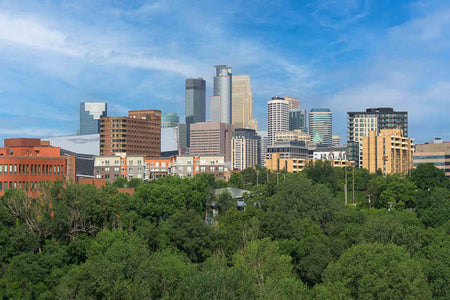Living in Alabama means experiencing the beauty of all four seasons. However, with the changing seasons comes the dreaded allergy season. If you find yourself constantly sneezing, itching, and dealing with a runny nose, you're not alone.
Allergy season in Alabama can be particularly challenging due to the high pollen count and various allergens in the air. In this blog post, we will explore the causes of allergies in Alabama and provide some tips to help you survive this allergy season.
What Causes Allergies in Alabama?
Allergies occur when your immune system overreacts to substances that are usually harmless, such as pollen, dust mites, or pet dander. In Alabama, the main culprit for allergies is pollen. The state is known for its abundance of trees, grasses, and flowers, which release pollen into the air during the spring and fall seasons. This high pollen count can trigger allergic reactions in many individuals.
Understanding Alabama Allergy By Season
The state's warm climate and diverse plant life create the perfect conditions for allergens to thrive. If you're an Alabama resident, it's important to understand how allergies can vary throughout the year.
Spring: Pollen Galore
Spring is a beautiful time in Alabama, but it's also the peak season for allergies. As the weather warms up, trees start to release pollen into the air. Oak, pine, and cedar trees are some of the biggest culprits. If you're allergic to tree pollen, you may experience symptoms like sneezing, itchy eyes, and a runny nose. To minimize your exposure, try to stay indoors during peak pollen times, keep your windows closed, and use an air purifier.
Summer: Mold and Grass
While summer brings relief from tree pollen, it introduces new allergens like mold and grass. The humid climate in Alabama creates the perfect breeding ground for mold. Additionally, grass pollen can cause symptoms like congestion and itchy throat. To reduce your exposure, keep your home dry and well-ventilated, mow your lawn regularly, and avoid outdoor activities during high pollen times.
Related: Summer Allergies Guide
Fall: Ragweed Takes Over
Fall is ragweed season in Alabama, and it's a tough time for allergy sufferers. Ragweed is a common weed that releases pollen into the air, causing symptoms like sneezing, coughing, and itchy eyes. This allergen can travel for miles, so even if you don't have ragweed in your immediate vicinity, you may still be affected. To minimize your exposure, keep your windows closed, change your clothes after spending time outdoors, and consider using a nasal rinse to flush out any allergens.
Related: Fall Allergies Guide
Winter: Indoor Allergens
While winter brings relief from outdoor allergens, it introduces a new set of challenges. Spending more time indoors can expose you to indoor allergens like dust mites, pet dander, and mold. These allergens can trigger symptoms like sneezing, coughing, and wheezing. To reduce your exposure, regularly clean your home, wash your bedding in hot water, and consider using a dehumidifier to control moisture levels.
Managing allergies in Alabama can be a year-round battle, but with the right knowledge and precautions, you can minimize your symptoms and enjoy the beauty of the state.
Allergens By Regions in Alabama
Here is an overview of common allergens found in different regions of Alabama
Coastal Region
The coastal region of Alabama, including cities like Mobile and Gulf Shores, is characterized by its warm and humid climate. This climate creates an ideal environment for mold growth, which can be a major allergen for many people. Additionally, the coastal region is home to a variety of trees, such as oak, pine, and cedar, which release pollen during the spring and fall seasons.
Central Region
The central region of Alabama, which includes cities like Birmingham and Montgomery, experiences a moderate climate with distinct seasons. In the spring, the central region sees a high pollen count due to the presence of trees like oak, birch, and maple. Grass pollen becomes a major allergen during the summer months, while weed pollen, such as ragweed, dominates the fall season.
Northern Region
The northern region of Alabama, encompassing cities like Huntsville and Florence, has a cooler climate compared to the rest of the state. This region is known for its beautiful landscapes and abundance of trees, including pine, cedar, and juniper. These trees release pollen during the spring and fall seasons, making it a challenging time for allergy sufferers.
Southern Region
The southern region of Alabama, which includes cities like Dothan and Enterprise, experiences a warm and humid climate similar to the coastal region. This region is characterized by its vast agricultural areas, where crops like peanuts and cotton are grown. These crops release pollen during their blooming periods, which can trigger allergies in susceptible individuals.
Mountain Region
The mountain region of Alabama, including cities like Gadsden and Anniston, has a cooler climate due to its higher elevation. This region is known for its scenic beauty and diverse plant life. Trees like oak, hickory, and pine release pollen during the spring and fall seasons, while grass pollen becomes a major allergen during the summer months.
It is important for individuals living in Alabama to be aware of the specific allergens prevalent in their region. By understanding the allergens and their corresponding seasons, individuals can take proactive measures to manage their allergies.
Alabama Allergy FAQ
Here are some frequently asked questions about allergy season in Alabama
What causes allergies in Alabama?
Primarily, allergies in Alabama are caused by pollen from plants and trees such as oak, pine, cedar, ragweed, and grass. Pollen is released at specific times of the year, triggering allergic reactions in susceptible individuals.
When is allergy season in Alabama?
Allergy season in Alabama typically starts in late winter or early spring when tree pollen is at its peak, followed by grass pollen season in late spring and summer, and ragweed season in the fall. However, allergies can occur year-round due to other allergens such as dust mites, mold, and pet dander
What are the common symptoms of allergies?
Allergies can manifest in various ways, but the most common symptoms include sneezing, a runny or stuffy nose, itchy or watery eyes, coughing, wheezing or shortness of breath, and skin rashes or hives.
How can I manage my allergies during allergy season?
While it may be impossible to avoid allergens completely, there are several steps you can take to mitigate your allergies. Pay attention to pollen forecasts and stay indoors when pollen counts are high. Keep your windows closed and use air conditioning to filter out allergens. Wash your hands and face frequently to remove pollen from your skin and hair. Use a nasal saline rinse to flush out allergens from your nasal passages, or consult a healthcare professional for over-the-counter medicine recommendations. Alternatively, try Allermi!









